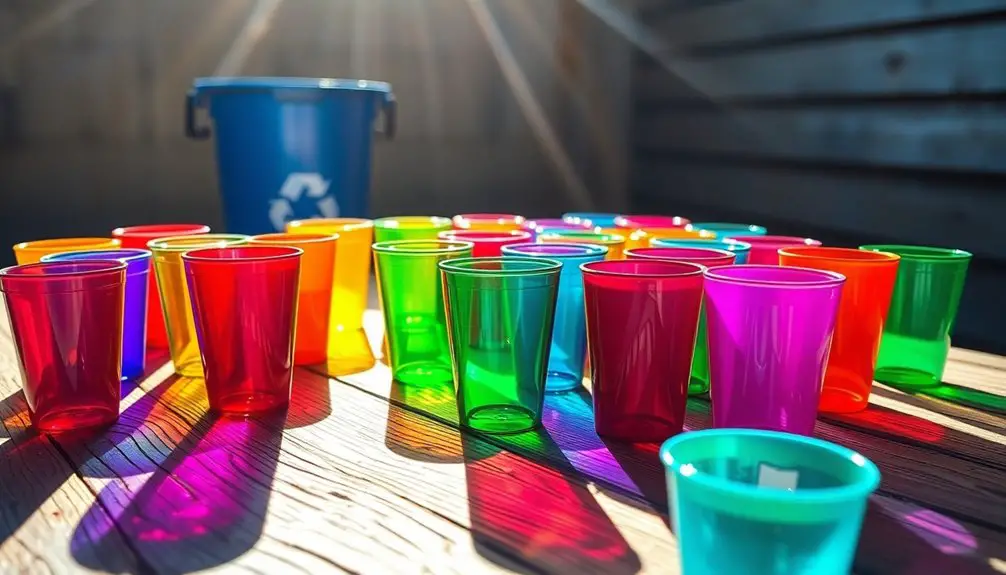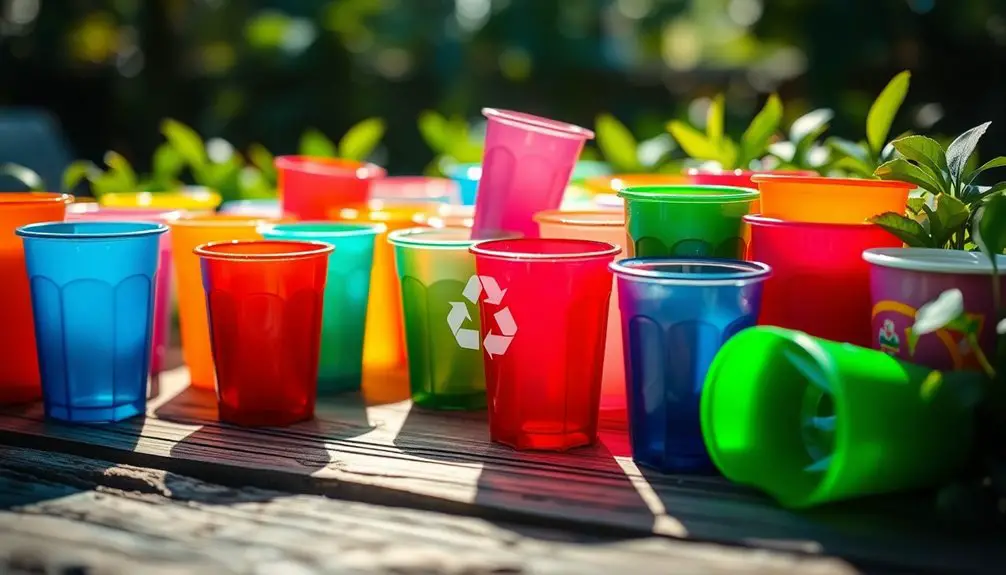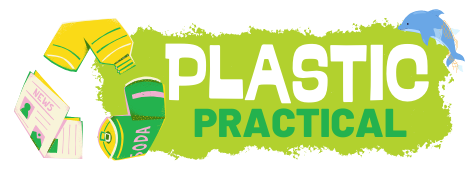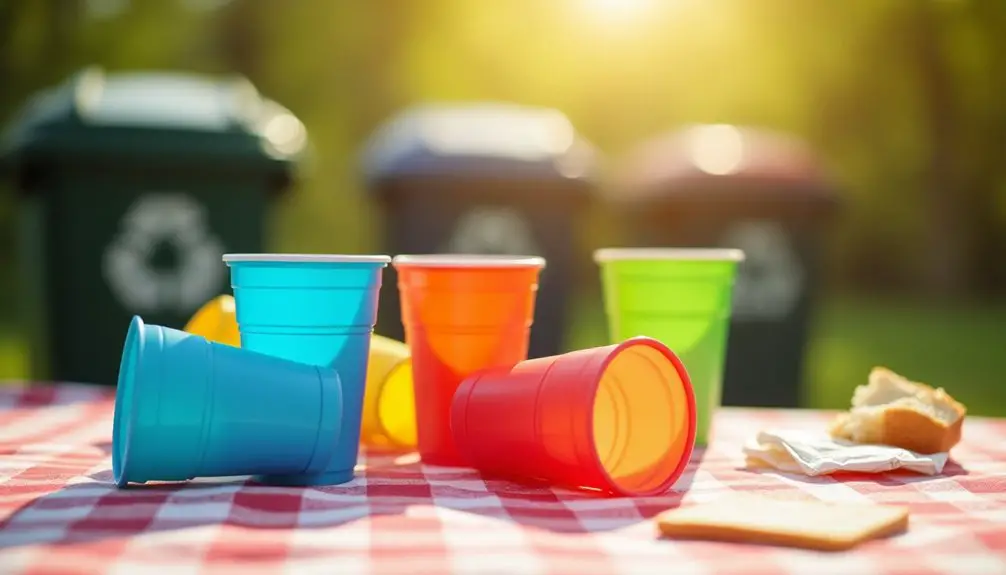Yes, plastic cups are generally recyclable, but it depends on their type and your local recycling guidelines. Many cups are made from polystyrene (#6) or polypropylene (#5), both of which can be recycled if clean and free of contamination. It's important to check local rules for what plastics they accept, as some areas won't recycle certain types. Proper sorting, cleaning, and understanding the recycling symbols can significantly boost recycling success. By making informed choices, you help reduce waste and protect the environment. If you're curious about best practices for recycling and the benefits of recycled plastic, keep exploring!
Key Takeaways
- Plastic cups can be recyclable, but it depends on their type and local recycling guidelines.
- Common types of plastic used for cups include Polystyrene (PS) and Polypropylene (PP), with varying recyclability.
- Always check for recycling symbols and local rules to ensure proper recycling of plastic cups.
- Clean and empty plastic cups improve recycling efficiency and reduce contamination in recycling streams.
- Participating in local recycling programs and understanding deposit refund systems can enhance recycling rates for plastic cups.
Importance of Recycling Plastic Cups
Why is recycling plastic cups so crucial? It's all about reducing landfill space. Each ton of recycled plastic saves 7.4 cubic yards from overflowing landfills. With the U.S. producing 35.4 million tons of plastic each year, recycling becomes vital in alleviating this burden. Additionally, recycling 1 ton of plastic can significantly reduce the volume of waste that ends up in landfills, making a substantial impact on our waste management efforts.
When you recycle plastic cups, you help prevent environmental pollution, reducing the chances of these cups breaking down into harmful microplastics that contaminate soil and waterways.
Moreover, recycling conserves energy and natural resources. It takes nearly 2,000 times more energy to produce a single-use plastic water bottle than a refillable one, so every cup you recycle makes a difference.
Using reusable cups not only cuts down on waste but also saves energy and resources over time.
Lastly, recycling plastic cups plays a significant role in environmental impact reduction. It lessens greenhouse gas emissions and helps avoid deforestation caused by producing alternatives like paper cups. The implementation of plastic alternatives can also reduce the environmental damage caused by single-use plastics, which is essential for promoting sustainability.
Types of Plastics Used
Understanding the types of plastics used in plastic cups is vital for effective recycling. Different types of plastics have unique properties and recyclability, which can influence how you dispose of them. Here's a quick overview of the most common plastics found in plastic cups:
| Type of Plastic | Recyclable Number |
|---|---|
| Polystyrene (PS) | 6 |
| Polypropylene (PP) | 5 |
| Polyethylene Terephthalate (PET) | 1 |
| High-Density Polyethylene (HDPE) | 2 |
| Styrene Acrylonitrile (SAN) | 7 |
Polystyrene is often used for disposable cups but is brittle. Polypropylene is durable and can handle hot liquids. PET cups are clear and shatter-resistant, making them popular for beverages. HDPE is strong and ideal for reusable cups, while SAN offers heat resistance and clarity. Understanding these differences helps you make informed choices about recycling and waste management, ensuring you contribute to a greener planet. The process of plastic recycling is complex and requires proper sorting to reduce contamination. Environmental concerns are prompting many restaurants to move away from polystyrene cups. Always check the bottom of your cup for the recyclable number to know how to dispose of it properly!
Recycling Process Overview

The recycling process for plastic cups kicks off with the critical step of collection, where used plastics are gathered from households and businesses.
You'll find recycling containers placed in public areas, especially in commercial districts and industrial zones. It's essential to separate plastic waste from common trash before disposing of it in these bins, as this increases the amount of material available for recycling.
Once collected, the plastic is transported to sorting facilities, where the presence of plastic contamination can significantly affect the efficiency of the recycling process.
Here, the plastic is separated by type, color, and thickness, often using machines or manual labor in smaller communities.
Efficient sorting is crucial, as most machines can only process one type of plastic at a time. Correct recycling practices minimize plastic waste in the environment and enhance human life quality by reducing harmful plastic presence.
After sorting, the plastic undergoes washing to remove impurities, such as dirt and organic residue, which enhances the quality of the final product.
The next step is shredding, where plastic is broken into smaller pieces, making it easier to transport and process.
Finally, identification and classification occur. Tests are performed to determine the quality and type of plastic, which is vital for effective recycling.
Accurate identification ensures that the right processes are applied moving forward, laying the groundwork for successful recycling.
Benefits of Recycled Plastic Cups
Recycled plastic cups offer a range of benefits that contribute to environmental sustainability and economic efficiency. By switching to reusable options, you can significantly reduce your carbon footprint. For instance, using a reusable cup can save over 10 kg of CO2 emissions after just 500 uses. In places like the UK and Scotland, this shift could lead to annual savings of thousands of tons of CO2 emissions. Additionally, transitioning to reusable cups could reduce carbon emissions by 69%(69%) annually, underscoring the substantial impact of making sustainable choices.
Moreover, opting for reusable cups helps decrease waste generation. You'll notice less litter in your surroundings, protecting wildlife and ecosystems. Reusable cups also reduce the complexity of recycling processes, making it easier to recycle materials effectively. This approach also supports the global effort to increase the plastic recycling rate, which currently stands at only 9% of plastics produced since the 1950s.
From a business perspective, adopting recycled plastic cups enhances your corporate image. You'll cut costs related to purchasing and disposing of single-use cups, while also promoting a green lifestyle that resonates with customers. This can foster customer loyalty as they appreciate your commitment to sustainability.
Lastly, recycling plastic cups conserves non-renewable resources and reduces energy consumption, contributing to overall resource conservation. By choosing recycled plastic cups, you're making a positive impact on the environment while enjoying long-term benefits.
Best Practices for Recycling

To maximize your recycling efforts, adopting best practices is crucial. Start by avoiding contaminants—don't toss plastic bags, bubble wrap, or clingy films into your curbside bins. Instead, take them to designated drop-off locations. Items smaller than a credit card can jam recycling equipment, so keep those out, too. Always ensure your recyclables are clean, empty, and dry; for instance, remove greasy parts from pizza boxes. Additionally, remember that food waste can lead to contamination, so keep your items free from any residue. Understanding plastic codes is essential to ensure you're recycling the correct materials.
Next, sort and clean your plastics. Separate them by type, remove labels, and rinse out any residue. Familiarize yourself with the recycling symbols on packaging to know how to recycle correctly. Combine loose plastics with other recyclables like cans and glass bottles.
Proper handling is also key. Use reusable shopping bags to cut down on single-use plastics. If your area has a Deposit Refund System, return beverage containers for a reward.
Remember to avoid crushing plastic items unless they're going into a Return Vending Machine. Lastly, understand what plastics are accepted in your local program to prevent contamination and support your recycling infrastructure.
Frequently Asked Questions
Can I Recycle Plastic Cups With Food Residue?
You can't recycle plastic cups with food residue. Make sure you empty, clean, and dry them before recycling. Contaminated cups can delay processing and reduce the value of recyclable materials.
How Do I Know if My Cups Are Recyclable?
To know if your cups are recyclable, check the resin code, inspect their condition, and research local recycling programs. Clean them thoroughly and follow specific guidelines for preparation to ensure proper recycling.
Are All Types of Plastic Cups Recyclable?
Not all plastic cups are recyclable. Clear ones typically are, but colored cups often aren't accepted due to contamination. Always check local recycling guidelines and consider using reusable options to reduce waste.
What Happens to Recycled Plastic Cups?
When you recycle plastic cups, they get sorted, cleaned, and processed. Unfortunately, many end up downcycled into lower-quality products or contaminated, so reusing cups is a better option to reduce waste.
How Can I Encourage Others to Recycle Plastic Cups?
To encourage others to recycle plastic cups, educate them on recycling symbols, promote proper preparation, and engage your community. Use social media and local events to spread awareness and lead by example in recycling efforts.

